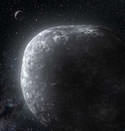

Image credit: NASA
The Hubble Space Telescope’s latest task is to track down elusive Pluto-like objects that lurk at the very edge of our Solar System – many of which seem to travel in pairs like Pluto and its moon Charon. These objects are classified as Kuiper Belt Objects (KBO) and can be found in a vast belt past Neptune. So far, 1% of KBOs have been found to be binary systems, a fact which puzzles astronomers.
NASA’s Hubble Space Telescope is hot on the trail of an intriguing new class of solar system object that might be called a Pluto “mini-me” ? dim and fleeting objects that travel in pairs in the frigid, mysterious outer realm of the solar system called the Kuiper Belt.
In results published today in the journal Nature, a team of astronomers led by Christian Veillet of the Canada-France-Hawaii Telescope Corporation (CFHT) in Kamuela, Hawaii, is reporting the most detailed observations yet of the Kuiper Belt object (KBO) 1998 WW31, which was discovered four years ago and found to be a binary last year by the CFHT.
Pluto and its moon Charon and countless icy bodies known as KBOs inhabit a vast region of space called the Kuiper Belt. This ‘junkyard’ of material left over from the solar system’s formation extends from the orbit of Neptune out to 100 times as far as the Earth is from the Sun (which is about 93 million miles) and is the source of at least half of the short-period comets that whiz through our solar system. Only recently have astronomers found that a small percentage of KBOs are actually two objects orbiting around each other, called binaries.
“More than one percent of the approximately 500 known KBOs are indeed binary: a puzzling fact for which many explanations will be proposed in what is going to be a very exciting and rapidly evolving field of research in the coming years,” says Veillet.
Hubble was able to measure the total mass of the pair based on their mutual 570-day orbit (a technique Isaac Newton used 400 years ago to estimate the mass of our Moon). The ‘odd-couple’ 1998 WW31 together are about 5,000 (0.0002) times less massive than Pluto and Charon.
Like a pair of waltzing skaters, the binary KBOs pivot around a common center of gravity. The orbit of 1998 WW31 is the most eccentric ever measured for any binary solar system object or planetary satellite. Its orbital distance varies by a factor of ten, from 2,500 to 25,000 miles (4,000 to 40,000 kilometers). It is difficult to determine how KBOs wind up traveling in pairs. They may have formed that way, born like twins, or may be produced by collisions where a single body is split in two.
Ever since the first KBO was discovered in 1992, astronomers have wondered how many KBOs may be binaries, but it was generally assumed that the observations would be too difficult for most telescopes. However, the insights to be gained from study of binary KBOs would be significant: measuring binary orbits provide estimates of KBO masses, and mutual eclipses of the binary allow astronomers to determine individual sizes and densities. Assuming some fraction of KBOs should be binary – just as has been discovered in the asteroid belt – astronomers eventually began to search for gravitationally entwined pairs of KBOs.
Then, finally, exactly a year ago on April 16, 2001, Veillet and collaborators announced the first discovery of a binary KBO: 1998 WW31. Since then, astronomers have reported the discoveries of six more binary KBOs. “It’s amazing that something that seems so hard to do and takes many years to accomplish can then trigger an avalanche of discoveries,” says Veillet. Four of those discoveries were made with the Hubble Space Telescope: two were discovered with a program led by Michael Brown of the California Institute of Technology in Pasadena, CA, and two more with a program led by Keith Noll of the Space Telescope Science Institute in Baltimore, MD. The sensitivity and resolution of Hubble is ideal for studying binary KBOs because the objects are so faint and so close together.
The Kuiper Belt is one of the last big missing puzzle pieces to understanding the origin and evolution of our solar system and planetary systems around other stars. Dust disks seen around other stars could be replenished by collisions among Kuiper Belt-type objects, which seems to be common among stars. These collisions offer fundamental clues to the birth of planetary systems.
Original Source: Hubble News Release
Now is the best time to observe Mars in 2025. Mars from 2014. Credit: Paul…
Scheduled for launch in 2027, the Nancy Grace Roman Telescope is slowly being readied for…
Few places in the solar system are better suited to a balloon than Titan. The…
We reported before about a NIAC-funded project known as the Lofted Environment and Atmospheric Venues…
The InSight Lander arrived on Mars in 2018 to study the planet's interior. Its mission…
It has been thought that the existence of plate tectonics has been a significant factor…